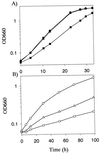Structural and functional analyses of photosynthetic regulatory genes regA and regB from Rhodovulum sulfidophilum, Roseobacter denitrificans, and Rhodobacter capsulatus
- PMID: 10400577
- PMCID: PMC93921
- DOI: 10.1128/JB.181.14.4205-4215.1999
Structural and functional analyses of photosynthetic regulatory genes regA and regB from Rhodovulum sulfidophilum, Roseobacter denitrificans, and Rhodobacter capsulatus
Abstract
Genes coding for putative RegA, RegB, and SenC homologues were identified and characterized in the purple nonsulfur photosynthetic bacteria Rhodovulum sulfidophilum and Roseobacter denitrificans, species that demonstrate weak or no oxygen repression of photosystem synthesis. This additional sequence information was then used to perform a comparative analysis with previously sequenced RegA, RegB, and SenC homologues obtained from Rhodobacter capsulatus and Rhodobacter sphaeroides. These are photosynthetic bacteria that exhibit a high level of oxygen repression of photosystem synthesis controlled by the RegA-RegB two-component regulatory system. The response regulator, RegA, exhibits a remarkable 78.7 to 84.2% overall sequence identity, with total conservation within a putative helix-turn-helix DNA-binding motif. The RegB sensor kinase homologues also exhibit a high level of sequence conservation (55.9 to 61.5%) although these additional species give significantly different responses to oxygen. A Rhodovulum sulfidophilum mutant lacking regA or regB was constructed. These mutants produced smaller amounts of photopigments under aerobic and anaerobic conditions, indicating that the RegA-RegB regulon controls photosynthetic gene expression in this bacterium as it does as in Rhodobacter species. Rhodobacter capsulatus regA- or regB-deficient mutants recovered the synthesis of a photosynthetic apparatus that still retained regulation by oxygen tension when complemented with reg genes from Rhodovulum sulfidophilum and Roseobacter denitrificans. These results suggest that differential expression of photosynthetic genes in response to aerobic and anaerobic growth conditions is not the result of altered redox sensing by the sensor kinase protein, RegB.
Figures






Similar articles
-
Regulated expression of a highly conserved regulatory gene cluster is necessary for controlling photosynthesis gene expression in response to anaerobiosis in Rhodobacter capsulatus.J Bacteriol. 1999 Jul;181(14):4334-41. doi: 10.1128/JB.181.14.4334-4341.1999. J Bacteriol. 1999. PMID: 10400592 Free PMC article.
-
Bacteriochlorophyll-dependent expression of genes for pigment-binding proteins in Rhodobacter capsulatus involves the RegB/RegA two-component system.Mol Genet Genomics. 2002 Apr;267(2):202-9. doi: 10.1007/s00438-002-0652-y. Epub 2002 Mar 2. Mol Genet Genomics. 2002. PMID: 11976963
-
DNA binding characteristics of RegA. A constitutively active anaerobic activator of photosynthesis gene expression in Rhodobacter capsulatus.J Biol Chem. 1998 Jul 17;273(29):18509-13. doi: 10.1074/jbc.273.29.18509. J Biol Chem. 1998. PMID: 9660820
-
RegB/RegA, a highly conserved redox-responding global two-component regulatory system.Microbiol Mol Biol Rev. 2004 Jun;68(2):263-79. doi: 10.1128/MMBR.68.2.263-279.2004. Microbiol Mol Biol Rev. 2004. PMID: 15187184 Free PMC article. Review.
-
RegB/RegA, a global redox-responding two-component system.Adv Exp Med Biol. 2008;631:131-48. doi: 10.1007/978-0-387-78885-2_9. Adv Exp Med Biol. 2008. PMID: 18792686 Review.
Cited by
-
Transcriptional control of expression of genes for photosynthetic reaction center and light-harvesting proteins in the purple bacterium Rhodovulum sulfidophilum.J Bacteriol. 2000 May;182(10):2778-86. doi: 10.1128/JB.182.10.2778-2786.2000. J Bacteriol. 2000. PMID: 10781546 Free PMC article.
-
Draft Genome Sequences of Three Closely Related Isolates of the Purple Nonsulfur Bacterium Rhodovulum sulfidophilum.Genome Announc. 2017 Mar 16;5(11):e00029-17. doi: 10.1128/genomeA.00029-17. Genome Announc. 2017. PMID: 28302776 Free PMC article.
-
Half-Site DNA sequence and spacing length contributions to PrrA binding to PrrA site 2 of RSP3361 in Rhodobacter sphaeroides 2.4.1.J Bacteriol. 2009 Jul;191(13):4353-64. doi: 10.1128/JB.00244-09. Epub 2009 May 1. J Bacteriol. 2009. PMID: 19411326 Free PMC article.
-
Involvement of the PrrB/PrrA two-component system in nitrite respiration in Rhodobacter sphaeroides 2.4.3: evidence for transcriptional regulation.J Bacteriol. 2002 Jul;184(13):3521-9. doi: 10.1128/JB.184.13.3521-3529.2002. J Bacteriol. 2002. PMID: 12057946 Free PMC article.
-
Metabolic signals that lead to control of CBB gene expression in Rhodobacter capsulatus.J Bacteriol. 2002 Apr;184(7):1905-15. doi: 10.1128/JB.184.7.1905-1915.2002. J Bacteriol. 2002. PMID: 11889097 Free PMC article.
References
-
- Bauer C E. Regulation of photosynthesis gene expression. In: Blankenship R E, Madigan M T, Bauer C E, editors. Anoxygenic photosynthetic bacteria. Dordrecht, The Netherlands: Kluwer Academic Publishers; 1995. pp. 1221–1234.
-
- Bauer C E, Bird T H. Regulatory circuits controlling photosynthesis gene expression. Cell. 1996;85:5–8. - PubMed
-
- Bauer C E, Buggy J, Mosley C. Control of photosystem genes in Rhodobacter capsulatus. Trends Genet. 1993;9:56–60. - PubMed
-
- Bauer C E, Young D A, Marrs B L. Analysis of the Rhodobacter capsulatus puf operon. J Biol Chem. 1988;263:4820–4827. - PubMed
Publication types
MeSH terms
Substances
Associated data
- Actions
- Actions
Grants and funding
LinkOut - more resources
Full Text Sources
Molecular Biology Databases

